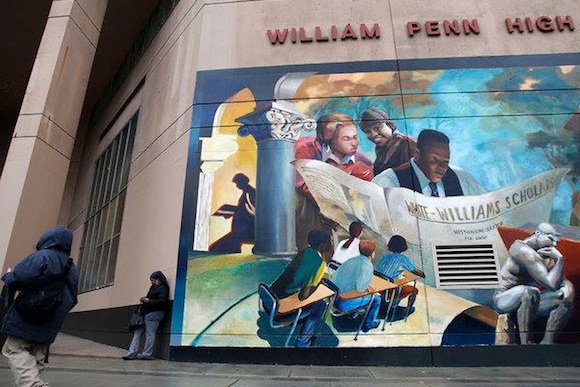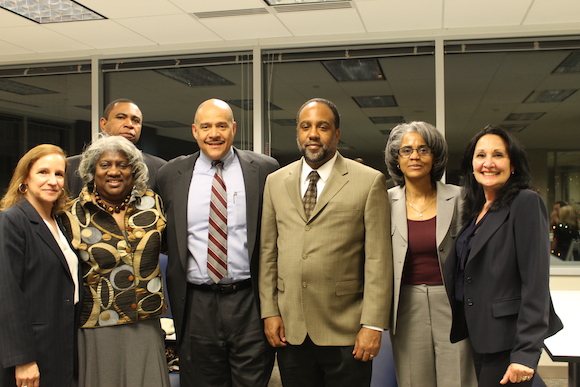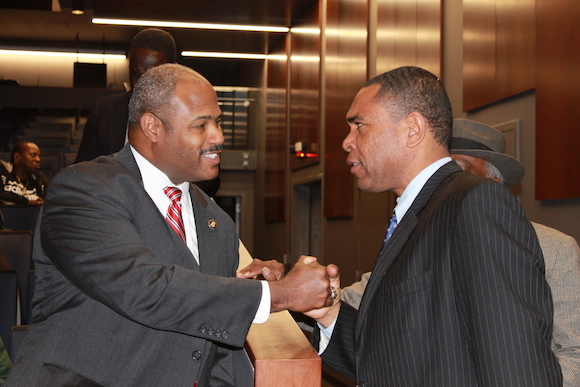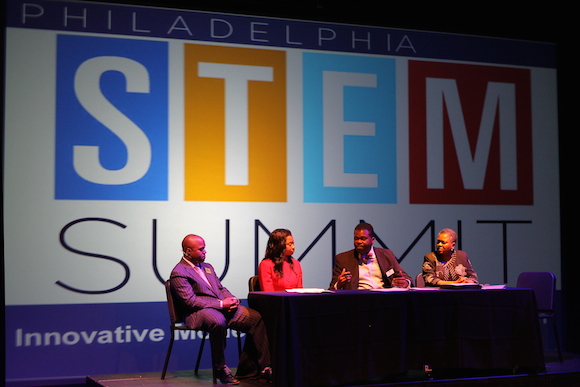The five-acre property in North Philadelphia near Broad and Master Streets has anchored the historic Yorktown neighborhood for decades, but local activists who want to re-establish a school there say they're in a frustrating limbo.
Valued at over $32,500,000 by Philadelphia's Office of Property Assessment, William Penn High School closed in 2010 in what was originally touted as a temporary measure, but the School District's deepening fiscal crisis left it shuttered. Advocates for reviving the school, who have coalesced into the William Penn Development Coalition (WPDC), have big plans for the site, if they can just get the ear of the School District.
William Penn is one of the most valuable pieces of real estate among the 23 schools closed by last year's School Reform Commission vote. WPDC president Inez Henderson-Purnell and the WPDC team are proposing a science, technology, engineering and math (STEM) public school curriculum. The Coalition is seeking a meeting with School District superintendent Dr. William Hite and School Reform Commission president William Green.
“Our position is, Dr. Hite, we're your hero,” explains Henderson-Purnell. “Take our plan, and let's just be heroes together. Our children deserve this future.”
The local groups comprising WPDC, including the Yorktown Community Organization (YCO) and the Philadelphia OIC, have been working together on and off for the last few years, first fighting the closure of the school, then advocating for revitalization, and, this spring, developing their first official organizational structure to advance concrete plans for a STEM-focused school.
But WPDC's limbo isn't just the silence they say they've encountered so far from the School District, whose representatives did not respond to Flying Kite's requests for comment. Ever since William Penn's neighbor to the north, Temple University, expressed interest in the site to the District last October, WPDC worries their plans for a new school will never come to be.
So, what does Temple want to do with the site?
Ray Betzner, associate vice president for executive communications at Temple, says that while the District has yet to make a request for proposals, Temple's plan for the site could include “an educational and training apprentice facility” through a partnership with the local Laborers' District Council.
Betzner adds that the undeveloped portion of the site, off Broad Street, could become an athletic practice or competition facility for sports like soccer and lacrosse.
WPDC members who spoke with Flying Kite are unanimous in their opposition to the idea of a new sports field there.
“There seems to be some small amount of cloak and dagger,” says Henderson-Purnell, referencing a lack of information from both Temple and the School District. “They're trying to keep things close, because the politics of it all can sometimes catch you off guard.”
City Council president Darrell Clarke, who represents Yorktown's district, isn't saying much either.
Councilman Clarke “is disappointed at the lack of urgency in repurposing the site,” responds spokesperson Jane Roh. “He hopes that the site eventually is brought back into productive use as a community asset and that, if sold by the School District, it provides the District with badly needed funding.”
To understand locals' worries, it's important to know Yorktown's history.
In the early 1960s, WPDC member Priscilla Woods' parents were among the original African-American “pioneers” who purchased homes in the 625-house residential rectangle between Tenth Street to the east, Broad Street to the west, Cecil B. Moore Avenue to the north and Girard Avenue to the south.
Later, she and her two brothers also bought homes in the neighborhood, now on the national register of historic places as “one of the first neighborhoods in the country where working African-American folks purchased brand-new homes,” she says.
Woods was the first president of the Yorktown Community Development Corporation (YCDC), which grew out of the original YCO and developed the Yorktown Arms senior-living complex. She went on to serve as the executive director of YCDC for two decades, and is proud of the way “Yorktown has stood strong and survived.”
But now, the neighborhood has “threats on all sides,” with Temple's development to the north and a steady march of gentrification to the south, threatening increased taxes and displacement of longtime residents.
And tensions already exist between the Yorktown community and university students.
According to Phil Harris, WPDC secretary (and son of a former William Penn principal), aspects of university life already disrupt the neighborhood, like “a lot of parties” and the aftermath of beer cans and more offensive litter. He worries that a new sports field next door could bring traffic, noise and stadium lighting, reducing residents' “control of the atmosphere of their neighborhood.” He notes that Yorktown wants to preserve its own character, “and not be an attachment of a university.”
But WPDC members also say that, in an ideal world, they would be glad to partner with Temple, the School District, or both on the school's curriculum.
Betzler says cooperation is what Temple wants, too: “Obviously we would work with the residents to make sure that whatever use that facility comes to would be in the best interests of the university and the community around it.”
He touted scholarship programs aimed at local students, as well as Temple's brand-new 1300-bed Morgan Hall at Broad and Cecil B. Moore, built as a direct response to feedback (both from the university and from the neighboring community) that more students should reside on campus.
Betzler also points out that many Yorktown residents are employees of the university, so “there are already natural alliances there.”
“We don't have any intention at all of disrupting the Yorktown community,” he adds.
As for WPDC's plans, “Our preference would be to reopen the school as a public school,” asserts Woods.
The inspiration for a STEM curriculum, which WPDC has been discussing and developing in meetings and summits throughout the last several months, comes in part from Dr. Chad Womack, a Philly native and the National Director for STEM Initiatives at the United Negro College Fund, who spoke at a WPDC meeting last November.
“We just need it to look like 21st or 22nd century education,” says Henderson-Purnell of balancing respect for the school's history with a forward-thinking mission.
Woods also emphasizes that, ultimately, locals do want the benefits of partnership with Temple.
“We want to get our children ready to go to Temple,” she says of establishing a quality neighborhood school.
If the District decides to revive a school on the site — whether that means the school district retains ownership and reopens in partnership with the WPDC proposal or WPDC buys the site and starts their own school from scratch — members say they're ready. As of April, Woods (who serves on the group's organizational development committee and is also the treasurer) says they've finalized their bylaws, filed their articles of incorporation with the state, and submitted their paperwork for 501 (c) 3 non-profit status.
“If we do not get the opportunity to work with the District, there are funding streams that are available to partner with us,” explains Woods, though she declines to say who those donors are.
WPDC is primed to move forward with their curriculum, their fundraising, and even their building design. “We've been asking to meet with [the District] and letting them know that it's urgent,” adds Woods.
And Harris says the demographics of the surrounding zip codes provided by State Representative Curtis Thomas's office could “definitely” fill a new school.
In early May, WPDC organizers finally received some news, even if it’s not exactly what they might have wished for. The School District has officially placed the 554,000-square-foot, five-story building up for sale with an asking price of $15 million. (Nineteen other facilities are also on offer.) WPDC is responding speedily with a public “town meeting” scheduled for 5 – 7 p.m. Thursday, May 15 at Mt. Olive Holy Temple on the corner of Broad and Jefferson.
For its part, the School District will hold an open house for prospective buyers on May 19 at 9 a.m.
“Renew your support of our children’s right to access quality education,” the WPDC urges neighbors and local constituents, who can attend the meeting to add their voices to the Coalition’s next step.
“What we're trying to do at Broad and Master can happen all over the city,” Henderson-Purnell concludes. “We're trying to get this doomsday of the District out of people's heads…But we have to have these grassroots organizations like ours to do something about it.”
ALAINA MABASO, a Philadelphia-based freelance journalist, has landed squarely in what people tell her is the worst possible career of the twenty-first century. So she makes Pennsylvania her classroom, covering everything from business to theater to toad migrations. After her editors go to bed, she blogs at http://alainamabaso.wordpress.com/. Find her on Twitter @AlainaMabaso.





